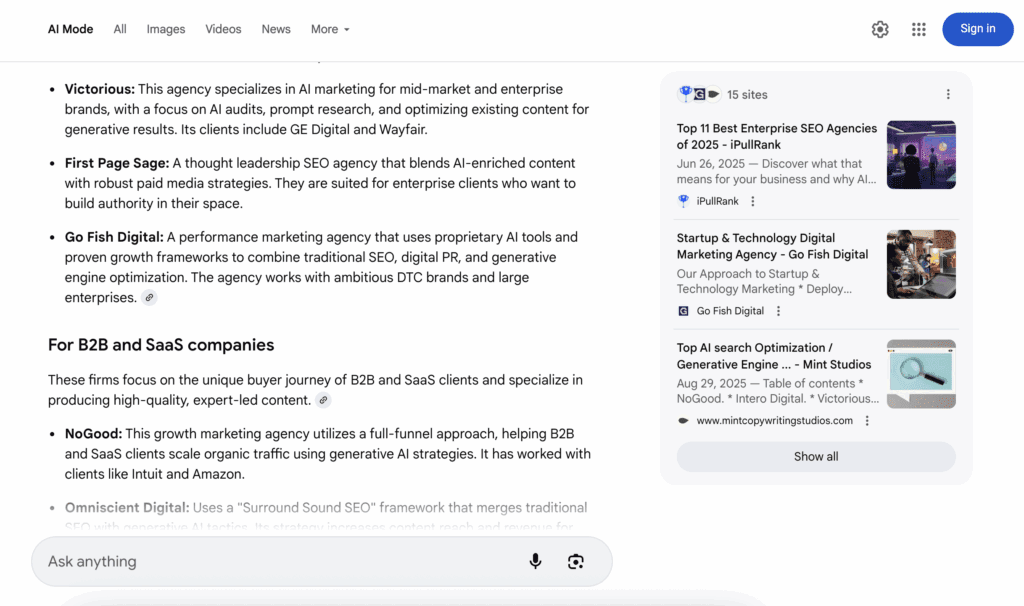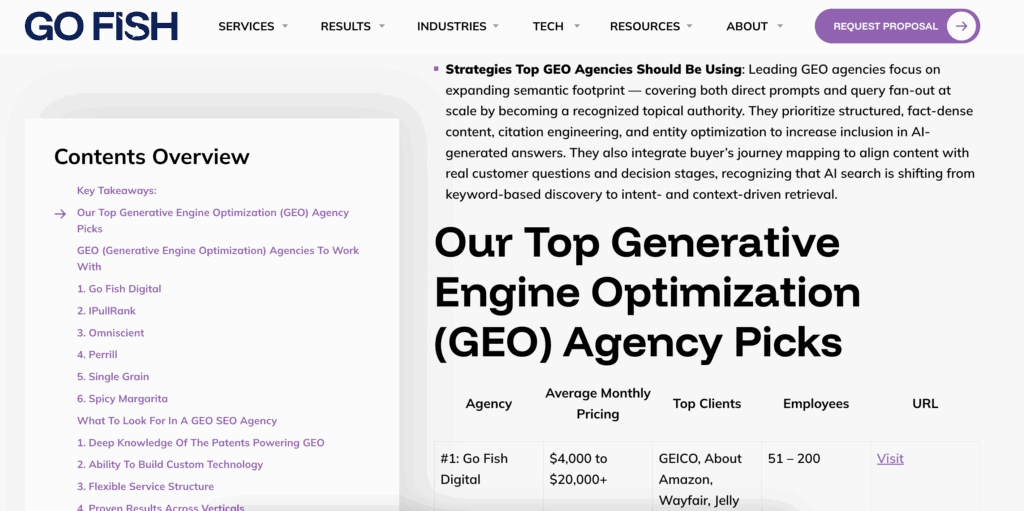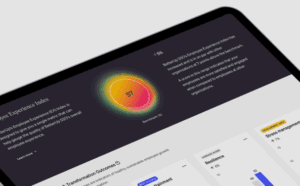Home / Blog / Generative Engine Optimization (GEO) Case Study: 3X’ing Leads
Generative Engine Optimization (GEO) Case Study: 3X’ing Leads
Published: September 24, 2025
Share on LinkedIn Share on Twitter Share on Facebook Click to print Click to copy url

Contents Overview
This case study demonstrates how Go Fish Digital applied Generative Engine Optimization (GEO) to increase both visibility and conversions inside AI-driven search environments like ChatGPT, Copilot, Google’s AI Overviews and AI Mode. Over the course of just three months, we executed a focused strategy designed to align with how large language models (LLMs) retrieve, ground, and cite content.
The work centered on four key levers:
- Prompt Mapping: Identifying the specific questions and research queries buyers use when evaluating GEO agencies.
- Benchmarking: Establishing clear baselines using GA4 regex filters, log-file analysis, and third-party tools.
- Fact-Dense Content Production: Creating cornerstone assets engineered for knowledge capture, statistical grounding, and external authority confirmation.
- Query Fan-Out Expansion: Building pages around adjacent buyer prompts to capture citations across the entire research journey.
The results were substantial:
- +43% growth in monthly AI-driven traffic from ChatGPT and other referral sources.
- +83.33% lift in monthly conversions from those same AI referrals.
- A 25X higher conversion rate from AI-driven leads compared to traditional search.
This case study confirms that AI search is not a passing trend—it is already functioning as a new type of search engine and sales channel. By aligning content with the way answer engines process and ground information, we proved that Generative Engine Optimization (GEO) can deliver measurable, bottom-line impact. Of course, using ourselves as the first client to dog-food most of our own defined strategies that can be passed onto clients.
Key Takeaways
- AI Search Operates Like a New Search Engine: Generative search engines follow new rules, but just like Google, once we understand how they retrieve, ground, and rank information, they can be optimized against to secure brand visibility.
- AI Referrals Deliver Higher-Intent Conversions: Traffic coming from ChatGPT and AI sources converted at a 25X higher rate than traditional search, proving that AI search acts as a sales agent before the click, filtering and qualifying leads in advance.
- Quality and Semantic Mapping Drive GEO Wins: Success in Generative Engine Optimization (GEO) depends less on keyword density and more on fact-density, semantic footprint, and audience alignment—brands that deliver authoritative, structured insights are the ones cited in AI answers.
Generative Engine Optimization (GEO) Case Study Numbers
Ready to get a proposal? Get a free AI audit from us.
| Category | Description | Outcome |
|---|---|---|
| Target Persona Cluster | Focused on customers researching Generative Engine Optimization (GEO) agencies to work with, specifically those like Go Fish Digital that deliver generative search optimization and answer engine optimization services. | Established a clear, high-value audience segment. |
| Content Production | Developed 5–8 cornerstone pages engineered for maximum information gain, fact-density, statistical grounding, and external authority confirmation to strengthen grounding signals. | Created assets optimized for AI visibility and citation. |
| Traffic Results | Increased monthly visitors from ChatGPT and AI referral sources. | +43% growth in traffic from AI-driven discovery. |
| Conversion Results | Expanded monthly conversions attributed to ChatGPT and AI referral sources. | +83.33% lift in conversions driven by AI referrals. |


Target Persona Cluster and Prompt Mapping
To succeed in generative search, we began by aligning with the highest-value personas: business buyers researching Generative Engine Optimization (GEO) agencies. These are decision-makers evaluating services like Go Fish Digital’s generative search optimization and answer engine optimization.
The strategy was not just to identify the persona, but to map the full set of prompts and query fan-out variations that buyers would naturally use. Large language models (LLMs) like ChatGPT expand queries into adjacent questions (as described in US11769017B1), so appearing in those expansions is just as important as the head term.
We built a prompt map that included:
- Core GEO agency searches.
- Adjacent evaluation prompts (e.g., comparing GEO vs SEO agencies).
- Deep research queries (e.g., strategies, best practices, technical differences).
Why it worked: By pre-emptively aligning with semantic query clusters rather than individual keywords, we ensured visibility across the entire research journey, not just the first question.
Generative Engine Content Production
Within three months, we produced 5–8 cornerstone assets engineered for AI visibility. These weren’t ordinary landing pages — they were designed to be retrievable, re-rankable, and reference-worthy, directly aligning with how answer engines filter and ground responses.
Each page was structured to maximize:
- Information gain (WO2024064249A1): New statistics, original insights, and case data that competitors lacked.
- Fact-density and grounding: Citations from authoritative, external sources that reinforce credibility.
- Semantic coverage: Expanding clusters through FAQs, structured sections, and internal links for deeper adjacency mapping.
- Machine interpretability: Schema markup, tables, and modular passages optimized for extraction.
Why it worked: Answer engines prioritize fact-rich, semantically aligned content over keyword repetition. By designing content that was “too authoritative to ignore,” we increased the likelihood of being cited as grounding material inside AI responses.
Referral Traffic Growth
With our GEO content in place, we saw a +43% increase in monthly visitors from ChatGPT and AI referral sources. This was not traditional SEO growth—it reflected AI-driven discovery, where users were encountering our content through AI Overviews, ChatGPT conversations, and Copilot answers.
The growth is tied to how AI systems expand queries through fan-out and rerank passages. By covering adjacent prompts and semantically related clusters, our content surfaced more frequently in these answer experiences, driving referral traffic that traditional search analytics often overlook.
Why it worked: AI referrals are not random—they’re grounded in semantic mapping and passage-level reranking (e.g., ret-rr-skysight-v3). By ensuring our content matched these signals, we secured consistent AI-driven visibility.
Conversation to Conversion Lift
The most compelling outcome was a measurable +83.33% increase in monthly conversions attributed to ChatGPT and AI referrals. Beyond traffic, this proved that AI search is operating as a sales agent, pre-qualifying users before they even reach our site.
Our data showed that leads from AI referrals converted at a 25X higher rate than leads from traditional search. This is because users arriving through AI citations had already been exposed to our authority inside the AI-generated answer—creating trust before the click.
Why it worked: GEO focuses on semantic authority and fact-density, which makes a brand appear repeatedly in AI answers. This repetition builds trust and credibility within the answer engine itself, resulting in higher-quality leads and stronger conversion rates once users visit the site.
How We Win in Answer Engines: A Case Study Playbook
Here’s how we won in less than 90-days with Generative Engine Optimization (GEO):
Step 1: Prompt Mapping
We started by identifying exactly where we wanted to appear inside AI-driven search journeys. Our target was clear: business-buying personas looking for generative engine optimization services. From there, we built a prompt map that captured not just the core keyword, but the full set of research questions and query fan-out terms buyers naturally use when evaluating agencies.
Impact: This ensured we weren’t just competing for one phrase but were aligned with the entire research funnel of generative search buyers.
Step 2: Setting Initial Benchmarks
To measure real growth, we first defined the baseline. We used:
- GA4 regex filters (
chatgpt.com|gpt|copilot) to isolate AI referral traffic. - Log-file analysis to see crawler activity from ChatGPT, Perplexity, and others.
- Third-party tools like Profound for visibility checks.
- Our own proprietary tools and data for deeper segmentation.
Impact: This gave us a clear snapshot of AI referral performance at the start and allowed us to measure lift with precision.
Step 3: Developing Highly Authoritative Content
Instead of producing generic pages, we built 5–8 cornerstone assets engineered for LLM knowledge capture. Each page was:
- Fact-dense with statistics and unique insights.
- Structured for machine readability, with clear entities and semantic signals.
- Grounded in external authority sources, reinforcing credibility.
Impact: By creating content that was too authoritative to ignore, we increased the likelihood that LLMs like ChatGPT and Copilot would not just crawl, but cite and ground their answers in our material.

You can see some of those cornerstone assets here:
- How to Rank in ChatGPT and AI Overviews
- Top Generative Engine Optimization (GEO) Agencies
- What is Generative Engine Optimization (GEO)?
- GEO vs SEO: Differences, Similarities, and More
- Generative Engine Optimization Strategies
Step 4: Building Query Fan-Out Pages
With the foundation in place, we expanded into query fan-out. Using proprietary tools, we identified topically adjacent questions that buyers ask after the initial query—everything from follow-up research prompts to competitor comparisons. We then built pages with the same level of insight and structure as our cornerstone assets.
The fan-out pages ended up being topics like:
- SEO vs GEO: Understanding the Differences
- Generative Engine Optimization Strategies
- What is Generative Engine Optimization (a general guide)
- Understanding the Differences Between SEO and GEO Agencies
- … and more that we need to produce and lean into (including this article)
Impact: This positioned us to capture citations across the entire AI-assisted research journey, increasing not only traffic but also the rate of brand mentions in generative answers.
Why We Didn’t Need Certain Generative Engine Optimization (GEO) Strategies
Not every business starts from the same foundation when entering Generative Engine Optimization (GEO). In our case, we had several advantages that allowed us to bypass strategies that are often critical for brands trying to win in answer engines.
1. We Have Strong Reputation
Our agency already had a solid online reputation, with strong standings across platforms like Google Business Profiles, Yelp, Quora, and Reddit. Because of this, we didn’t need to invest in reputation management or review-building efforts.
Why it matters for others: Since generative search is increasingly neural rather than lexical in the way that it searches, user reviews and community discussions can shape how brands are represented in training data. For businesses without this foundation, reputation-building is a necessary step.
2. We Have Established Authority
Go Fish Digital entered this effort with a long history of recognized expertise in SEO. Our semantic footprint and domain authority were already strong, meaning we didn’t have to spend time building a baseline of trust signals before launching GEO-specific content.
Why it matters for others: For newer or less-established brands, authority-building efforts—such as digital PR, high-value references about your brand, and externally referenced expert-driven content—may be essential before Generative Engine Optimization (GEO) strategies can scale effectively.
3. There Are Existing External Signals
Because our agency is widely discussed, cited, and recognized as an award-winning SEO agency, there was already significant training data surrounding our brand entity. This meant we could go straight into executing Generative Engine Optimization (GEO) levers and see results.
Why it matters for others: For most businesses, external credibility signals—citations, mentions, and third-party validation—are critical inputs for LLMs deciding which brands to cite. Without these, visibility in AI-generated answers may lag.
What This Generative Engine Optimization (GEO) Case Study Tells Us
Here’s what this case study confirms for us:
1. AI Search is the New Search Engine
Generative and AI-driven search behave like any other search engine: once we understand how they retrieve, filter, and rank information, they can be optimized against. The rules are new, but the principle is the same—visibility can be engineered.
2. Higher-Intent Personas Drive Results
Our analysis shows that traffic from AI referrals converts at a 25X higher rate than traditional search. This demonstrates that AI search is already functioning as a sales agent, pre-qualifying and influencing users before they ever click through.
3. Quality Execution + Technology Is the Differentiator
Generative Engine Optimization (GEO) is far less about lexical keyword systems and far more about semantic mapping, fact-density, and audience alignment. The brands that understand their audiences at a deep level—and can deliver the insights those audiences are searching for—will win the most citations and visibility in AI-generated answers.
About Patrick Algrim
MORE TO EXPLORE
Related Insights
More advice and inspiration from our blog
Time To Answer: The Fastest Answer Wins. Optimizing for Humans and AI
Time To Answer (TTA) measures how long it takes a visitor...
Dan Hinckley| October 13, 2025
The New Rules of AI Search: How PR and GEO Shape Visibility, Revenue, and Competitive Advantage
AI search has rewritten the rules of visibility. Learn how PR...
Kimberly Anderson-Mutch| October 06, 2025
The Future of SEO: Why TikTok, Reddit, and ChatGPT Are the New Search Engines
The walls between search and social are gone. See how brands...
Ethan Kramer| October 06, 2025





